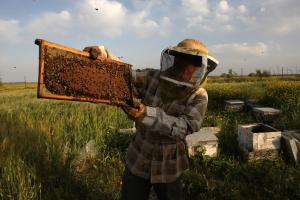MONTEVIDEO, Uruguay, June 13 (UPI) — Primates aren’t the only animals who groom one another. New research suggests some species of honeybees battle parasitic varroa mite infections by grooming.
The new study, published in the Journal of Apicultural Research, shows honeybees work to dislodge the varroa mites via both autogrooming and allogrooming. Autogrooming is any solo-based action that dislodges invading mites, while allogrooming is any grooming behavior that involves interactions between two or more honeybees.
Because varroa mites, Varroa destructor, have become more resistant to many treatments, researchers are now looking to breed bee hybrids that are more resistant to the mites themselves.
Scientists in Uruguay compared the grooming abilities of Africanized bees, hybrids of Apis mellifera scutellata, and an Italian honeybee strain, Apis mellifera ligustica.
When placed in a petri dish and infected with mites, the Africanized bees were more reactive than their Italian counterparts. More dead or injured mites were found in petri dishes vacated by groups of infected Africanized bees, suggesting they are more successful groomers.
“Africanized bees are characterized by presenting higher resistance to V. destructor than European bees,” researchers wrote in the paper. “This study shows that such difference can be, partly due to grooming behavior.”
“This interesting study adds to our knowledge about resistance mechanisms, and may aid the search for bees resistant to varroa,” Norman Carreck, science director at the International Bee Research Association, concluded in a news release.

COMMENTS
Please let us know if you're having issues with commenting.